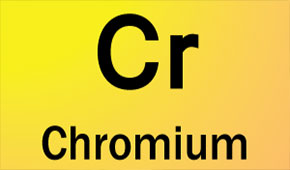Chromium is a metallic element that humans require in very small amounts. It is an essential part of metabolic processes that regulate blood sugar, and helps insulin transport glucose into cells, where it can be used for energy. Chromium also appears to be involved in the metabolism of carbohydrate, fat, and protein. Two forms are commonly available as supplements: glucose-tolerance factor (GTF) chromium and chromium picolinate.
Why is chromium necessary?
Chromium enhances the actions of insulin and is necessary for maintaining normal metabolism and storage of fats, proteins and carbohydrates. Inadequate intake of chromium has been linked to the development of glucose intolerance, a condition seen in type 2 diabetes. Chromium can also help raise HDL ("good") cholesterol levels, and may play a role in preventing heart disease.
What are the signs of a deficiency?
An estimated 25-50% of the U.S. population is mildly deficient in chromium, a greater incidence of deficiency than is found in almost any other developed country. The industrialization of the American food supply chain, reflected in very low soil levels of chromium and the loss of chromium from refined foods, especially sugar and flours, probably contributes to this. Dietary chromium has a low absorption rate, which becomes even lower with age, so the elderly are especially at risk. Life threatening clinical deficiency may be rare, but deficiency is common.
Because adequate dietary chromium helps to maintain insulin sensitivity, chromium deficiency can contribute to the development of diabetes and metabolic syndrome. Even mild deficiencies of chromium can produce problems in blood sugar metabolism, and contribute to other symptoms such as anxiety or fatigue. Altered cholesterol metabolism, accelerated atherosclerosis, decreased growth in young people and delayed healing time after injuries or surgery can result from chromium deficiency.
How much, and what kind, does an adult need?
The National Institutes of Health (NIH) recommends:
males 19-50, 35 mcg per day
men over 50, 30 mcg per day
females 19-50, 25 mcg per day
females over 50, 20 mcg per day
pregnant females over 19, 30 mcg per day
lactating females over 18, 45 mcg per day
How much does a child need?
According to the NIH:
infants 0-6 months, .2 mcg per day
babies 7-12 months, 5.5 mcg per day
children 1-3 years, 11 mcg per day
children 4-8 years, 15 mcg per day
young males 9-13, 25 mcg per day
young females 9-13, 21 mcg per day
teen males 14-18, 35 mcg per day
teen females 14-18, 25 mcg per day
How do you get enough chromium from foods?
Brewer's yeast, broccoli, grape juice, meat and whole-grain products are all excellent sources. Some fruits, vegetables, and spices provide chromium. Romaine lettuce, raw onions and ripe tomatoes are all good sources. Table below showed selected food sources of chromium:
Food
Chromium (mcg)
Broccoli, ½ cup
11
Grape juice, 1 cup
8
Potatoes, mashed, 1 cup
3
Garlic, dried, 1 teaspoon
3
Basil, dried, 1 tablespoon
2
Beef cubes, 3 ounces
2
Orange juice, 1 cup
2
Turkey breast, 3 ounces
2
Whole wheat bread, 2 slices
2
Apple, unpeeled, 1 medium
1
Banana, 1 medium
1
Green beans, ½ cup
1
What affects chromium levels in the body?
Absorption of chromium from the intestinal tract is low, ranging from less than 0.4% to 2.5% of the amount consumed, and the remainder is excreted in the feces. Enhancing the mineral's absorption are vitamin C (found in fruits and vegetables and their juices) and the B vitamin niacin (found in meats, poultry, fish, and grain products). Absorbed chromium is stored in the liver, spleen, soft tissue, and bone.
The body's chromium content may be reduced under several conditions. Diets high in simple sugars (comprising more than 35% of calories) can increase chromium excretion in the urine. Infection, acute exercise, pregnancy and lactation, and stressful states (such as physical trauma) increase chromium losses and can lead to deficiency, especially if chromium intakes are already low.
Are there any risks associated with too much chromium?
Researchers have not found any toxic effects that result from taking high doses of chromium.
What are chromium and drugs interactions?
Certain medications may interact with chromium, especially when taken on a regular basis. Before taking dietary supplements, check with your doctor or other qualified healthcare provider, especially if you take prescription or over-the-counter medications.
Table below showed interactions between chromium and medications:
Medications
Nature of interaction
Antacids
Corticosteroids
H2 blockers (such as cimetidine, famotidine, nizatidine, and rantidine)
Proton-pump inhibitors (such as omeprazole, pantoprazole, and esomeprazole)
These medications alter stomach acidity and may impair chromium absorption or enhance excretion
Beta-blockers (such as atenolol or propanolol)
Corticosteroids
Insulin
Nicotinic acid
Nonsteroidal anti-inflammatory drugs (NSAIDS)
Prostaglandin inhibitors (such as ibuprofen, indomethacin, naproxen, piroxicam, and aspirin)
These medications may have their effects enhanced if taken together with chromium or they may increase chromium absorption
 English
English فارسی
فارسی 
